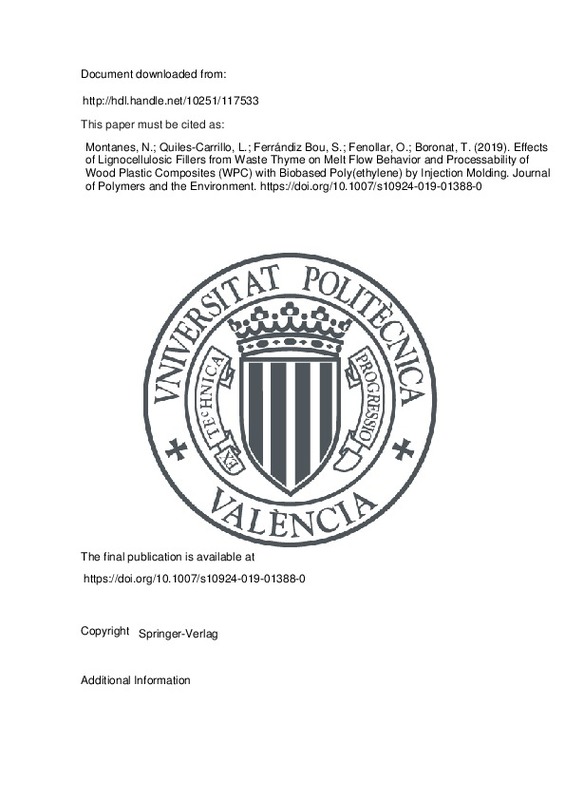Koivuranta E et al (2017) Improved durability of lignocellulose-polypropylene composites manufactured using twin-screw extrusion. Compos Part A 101:265–272
Tufan M et al (2016) Technological and thermal properties of thermoplastic composites filled with heat-treated alder wood. BioResources 11(2):3153–3164
Puglia D, Fortunati E, Kenny JM, Editors (2016) Extraction of lignocellulosic materials from waste products. In: Multifunctional polymeric nanocomposites based on cellulosic reinforcements. Elsevier, Oxford, p 408
[+]
Koivuranta E et al (2017) Improved durability of lignocellulose-polypropylene composites manufactured using twin-screw extrusion. Compos Part A 101:265–272
Tufan M et al (2016) Technological and thermal properties of thermoplastic composites filled with heat-treated alder wood. BioResources 11(2):3153–3164
Puglia D, Fortunati E, Kenny JM, Editors (2016) Extraction of lignocellulosic materials from waste products. In: Multifunctional polymeric nanocomposites based on cellulosic reinforcements. Elsevier, Oxford, p 408
Huang L et al (2016) Sustainable use of coffee husks for reinforcing polyethylene composites. J Polym Environ 26:48–58
Fabiyi JS et al (2008) Wood plastic composites weathering: visual appearance and chemical changes. Polym Degrad Stab 93(8):1405–1414
Ruiz-Navajas Y et al (2013) In vitro antioxidant and antifungal properties of essential oils obtained from aromatic herbs endemic to the southeast of Spain. J Food Prot 76(7):1218–1225
Díaz-García MC et al (2015) Production of an anthocyanin-rich food colourant from Thymus moroderi and its application in foods. J Sci Food Agric 95(6):1283–1293
Bhullar SK, Kaya B, Jun MB-G (2015) Development of bioactive packaging structure using melt electrospinning. J Polym Environ 23(3):416–423
Cicala G et al (2016) Investigation on structure and thermomechanical processing of biobased polymer blends. J Polym Environ 25:750–758
George J et al (1996) Melt rheological behaviour of short pineapple fibre reinforced low density polyethylene composites. Polymer 37(24):5421–5431
Joseph PV et al (2002) Melt rheological behaviour of short sisal fibre reinforced polypropylene composites. J Thermoplast Compos Mater 15(2):89–114
Kalaprasad G et al (2003) Melt rheological behavior of intimately mixed short sisal-glass hybrid fiber-reinforced low-density polyethylene composites. I. Untreated fibers. J Appl Polym Sci 89(2):432–442
Kalaprasad G, Thomas S (2003) Melt rheological behavior of intimately mixed short sisal-glass hybrid fiber-reinforced low-density polyethylene composites. II. Chemical modification. J Appl Polym Sci 89(2):443–450
Kumar RP et al (2000) Morphology and melt rheological behaviour of short-sisal-fibre-reinforced SBR composites. Compos Sci Technol 60(9):1737–1751
Li T, Wolcott M (2005) Rheology of wood plastics melt. Part 1. Capillary rheometry of HDPE filled with maple. Polym Eng Sci 45(4):549–559
Li T, Wolcott M (2006) Rheology of wood plastics melt, part 2: effects of lubricating systems in HDPE/maple composites. Polym Eng Sci 46(4):464–473
Li TQ, Wolcott MP (2004) Rheology of HDPE-wood composites. I. Steady state shear and extensional flow. Composites Part A 35(3):303–311
Mohanty S, Nayak SK (2007) Rheological characterization of jute/HDPE composites. In: Zhang D et al. (eds) Advanced materials and processing Iv, p 279
Ou R et al (2014) Effect of wood cell wall composition on the rheological properties of wood particle/high density polyethylene composites. Compos Sci Technol 93:68–75
Hristov V, Vlachopoulos J (2007) Influence of coupling agents on melt flow behavior of natural fiber composites. Macromol Mater Eng 292(5):608–619
Mohanty S, Nayak SK (2007) Rheological characterization of HDPE/sisal fiber composites. Polym Eng Sci 47(10):1634–1642
Koszkul J, Nabialek J (2004) Viscosity models in simulation of the filling stage of the injection molding process. J Mater Process Technol 157–158:183–187
Mazzanti V, Mollica F (2016) In-process measurements of flow characteristics of wood plastic composites. J Polym Environ 25:1044–1050
Montanes N et al (2017) Processing and characterization of environmentally friendly composites from biobased polyethylene and natural fillers from thyme herbs. J Polym Environ 26:1218–1230
Shenoy A, Saini D (1984) Rheological models for unified curves for simplified design calculations in polymer processing. Rheologica Acta 23(4):368–377
Bagley E (1957) End corrections in the capillary flow of polyethylene. J Appl Phys 28(5):624–627
Rabinowitsch B (1929) Über die Viskosität und Elastizität von Solen. Z Physik Chem A 145:1–26
Cross MM (1965) Rheology of non-newtonian fluids—a new flow equation for pseudoplastic systems. J Colloid Sci 20(5):417
Williams ML, Landel RF, Ferry JD (1955) Mechanical properties of substances of high molecular weight. 19. the temperature dependence of relaxation mechanisms in amorphous polymers and other glass-forming liquids. J Am Chem Soc 77(14):3701–3707
Carneiro OS, Maia JM (2000) Rheological behavior of (short) carbon fiber/thermoplastic composites. Part I: the influence of fiber type, processing conditions and level of incorporation. Polym Compos 21(6):960–969
Crowson RJ, Folkes MJ, Bright PF (1980) Rheology of short glass fiber-reinforced thermoplastics and its application to injection molding I. Fiber motion and viscosity measurement. Polym Eng Sci 20(14):925–933
Goldsmith H (1967) Rheology theory and application, Mason SG (eds) Academic Press, p 85
Reig MJ, Segui VJ, Zamanillo JD (2005) Rheological behavior modeling of recycled ABS/PC blends applied to injection molding process. J Polym Eng 25(5):435–457
Părpăriţă E et al (2014) Structure–morphology–mechanical properties relationship of some polypropylene/lignocellulosic composites. Mater Des 56:763–772
Kurt M et al (2009) Experimental investigation of plastic injection molding: assessment of the effects of cavity pressure and mold temperature on the quality of the final products. Mater Des 30(8):3217–3224
[-]







![[Cerrado]](/themes/UPV/images/candado.png)


